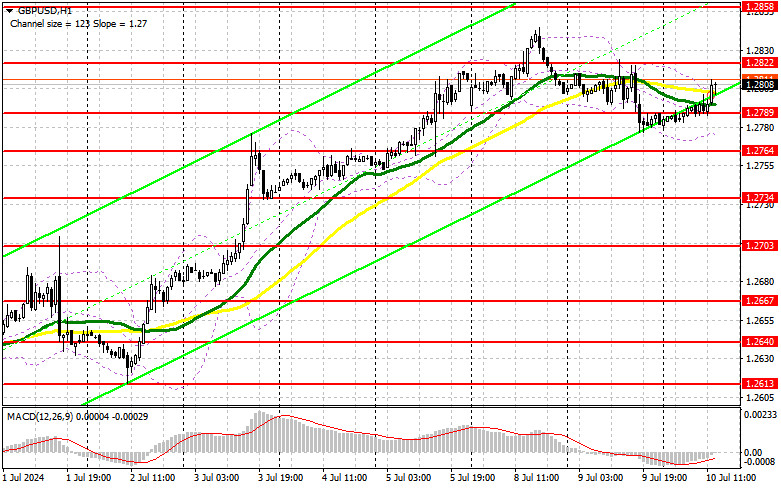
In my morning forecast, I highlighted the 1.2799 level and planned to make market entry decisions based on it. Let's look at the 5-minute chart and see what happened. The rise and the formation of a false breakout around 1.2799 allowed for entering short positions to continue yesterday's trend. Still, after a 10-point downward movement, demand for the pound returned, leading to a return to the 1.2799 area. The technical picture for the second half of the day has been slightly revised.

Considering the lack of UK statistics and the substantial drop of the pound yesterday compared to other risk assets, the bulls seized the moment and bought part of the decline. In the second half of the day, there is no need to pay attention to Fed Chairman Jerome Powell's speech, as he will repeat what he said yesterday in the Senate. Given the absence of other important statistics, demand for the pound will likely remain for a while, but the pair's strong and directional movement is unlikely in the second half of the day. I prefer to act on the decline from the new support at 1.2789, formed by the results of the first half of the day. A false breakout formation will provide a good entry point for long positions with the prospect of updating the 1.2822 high. A breakout and retest from top to bottom of this range will strengthen the pound's upward potential, leading to an entry point for long positions with a possible test of 1.2858. The furthest target will be the 1.2890 area, where I will take profits. If GBP/USD declines and shows no bull activity around 1.2789 in the second half of the day, pressure on the pair will increase. This will also lead to a decline and update of the next support at 1.2764, increasing the chances of a bearish correction. Therefore, only a false breakout formation will be suitable for opening long positions. I plan to buy GBP/USD immediately on a rebound from the 1.2734 minimum, targeting a 30-35 point correction within the day.
For Opening Short Positions in GBP/USD:Sellers tried, but the pound's upward potential seems much stronger than the desire to push it to the weekly low. Many believe that US inflation will continue to decline, supporting risk assets, including the pound, and are in no hurry to get rid of it. But we will find out about this only tomorrow. Today, I prefer to act on selling only after forming a false breakout around the new resistance at 1.2822, formed by yesterday's results. This will provide a suitable condition for opening short positions to reduce support at 1.2789, where the moving averages favor the bulls. A breakout and retest from the bottom to the top of this range will hit the buyers' positions, triggering stop orders and opening the way to 1.2764. The furthest target will be the 1.2734 area, where I will take profits. Testing this level will severely harm the pound's upward potential. If GBP/USD rises and shows no activity around 1.2822 in the second half of the day, buyers will have a chance to continue the growth. In this case, I will postpone selling until a false breakout at 1.2858. If there is no downward movement, I will sell GBP/USD immediately on a rebound from 1.2890, targeting only a 30-35 point downward correction within the day.

Moving Averages:
Trading is conducted around the 30 and 50-day moving averages, indicating a sideways market.
Note: The author considers the period and prices of the moving averages on the hourly H1 chart, which differs from the general definition of classic daily moving averages on the D1 daily chart.
Bollinger Bands:
In case of a decline, the lower boundary of the indicator, around 1.2775, will act as support.
Indicator Descriptions:Moving average: Determines the current trend by smoothing volatility and noise. Period 50. Marked in yellow on the chart.Moving average: Determines the current trend by smoothing volatility and noise. Period 30. Marked in green on the chart.MACD Indicator: Moving Average Convergence/Divergence. Fast EMA period 12. Slow EMA period 26. SMA period 9.Bollinger Bands: Period 20.Non-commercial traders are speculators such as individual traders, hedge funds, and large institutions that use the futures market for speculative purposes and meet certain requirements.Long non-commercial positions: Represent the total long open position of non-commercial traders.Short non-commercial positions: Represent the total short open position of non-commercial traders.Total non-commercial net position: The difference between non-commercial traders' short and long positions.